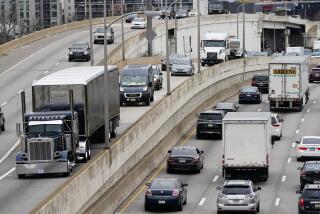Simpler Car Seats Aim for Safety
- Share via
Protecting children in cars has come a long way from a few decades ago when kids sat unrestrained without as much as a seat belt.
But many parents still complain that today’s child safety seats are difficult to use, and federal studies show that the vast majority are used incorrectly.
This week, the federal government is taking a step toward addressing those issues with new requirements intended to make car seats easier to use.
The law requires car-seat makers to produce seats with metal fittings that snap or hook into short metal anchors in the car. Automobile makers must install the anchors in the right and left sides of rear passenger seats of all cars, minivans and light trucks manufactured starting this month. The system, known as Latch (short for Lower Anchors and Tethers for Children), should help adults install a car seat quickly and correctly--words that, in the past, have rarely been used to describe car-seat installation.
“This is the easiest system to get your kid in,” says Ellen Martin of the National Highway Traffic Safety Administration. “You don’t need a PhD to get the seat in. It’s not foolproof, but we think it will save lots of lives.”
According to the federal government, 80% of child safety seats are used incorrectly. Until now, the likelihood that a car seat would protect a passenger in an accident depended largely on an adult’s ability to use the seat belts. The Latch system seats snap into place and should not move more than an inch forward or sideways. In forward-facing car seats, a tether at the top of the car seat helps hold the seat tightly in place so that a child’s head won’t move too far forward during a crash. The system may prevent 50 deaths and 3,000 injuries per year, according to Martin. Last year, 649 children younger than 5 died in car crashes.
“This should provide more consistency and something that will be easier for people, on the whole, to learn about,” says Stephanie M. Tombrello, executive director of SafetyBeltSafe USA, a Torrance nonprofit organization dedicated to child passenger safety.
Tombrello, however, is critical of the government’s decision to allow car-seat manufacturers to produce two different kinds of Latch restraint systems. One has a flexible lower anchor that uses a hook attached to a length of belt webbing that is tightened like a seat belt. The other type is a rigid anchor that clamps onto the car’s anchor. The flexible anchor allows room for error, she says.
“The rigid anchor is much less likely to cause problems,” she says.
The new car seats are expected to cost at least $10 more than current car seats, with the rigid lower anchor seats costing the most. Families with older cars and car seats still may use those seats, but there are ways to retrofit both cars and car seats to the Latch system.
Some older car seats can be retrofitted with lower anchor attachments that will work in new-model cars with the Latch anchors. Retrofit kits can be found in many child specialty stores, such as Toys R Us. Parents should make sure they buy a kit that will fit the particular car-seat brand and model, Tombrello says.
For families with older cars without the Latch anchors, the Latch-equipped seats can still be installed using the seat belts. You may also be able to add a tether anchor mounting in an older vehicle by requesting a kit from your vehicle’s manufacturer. However, Tombrello says she does not believe that the majority of auto makers are providing retrofitting kits. Consumers can find more information on the Latch system at SafetyBeltSafe’s Web site, www.carseat.org.
Older car seats are still safe when used properly, safety experts say.






